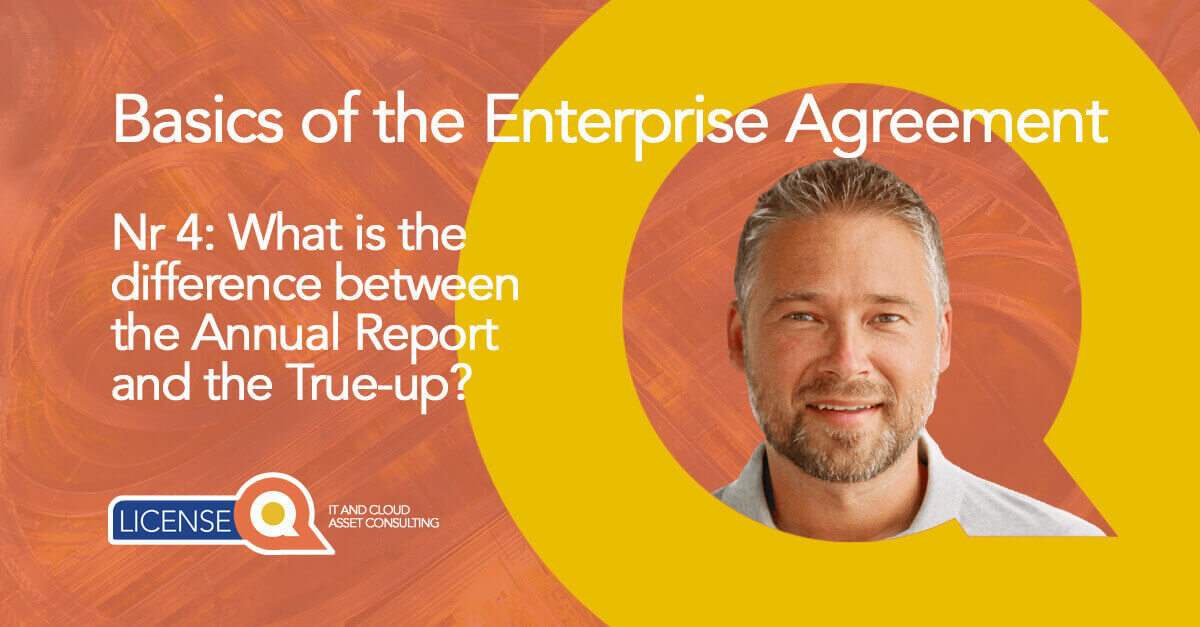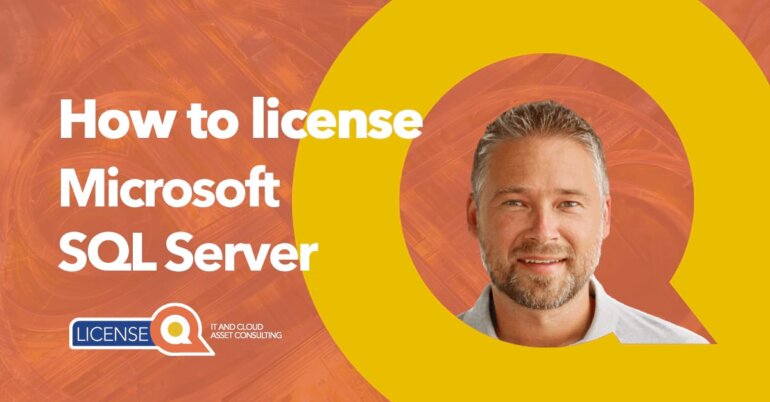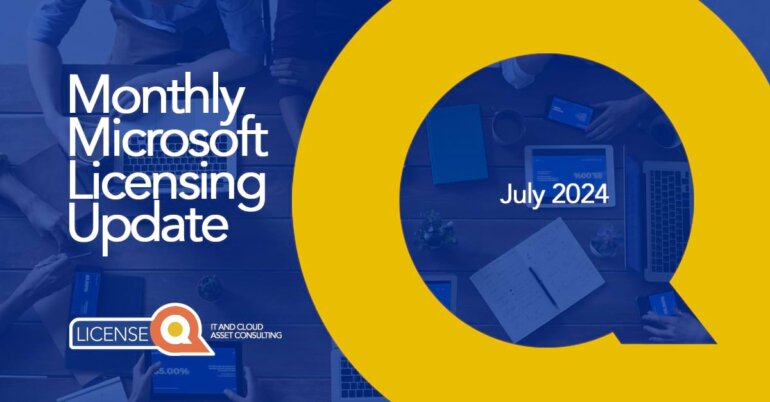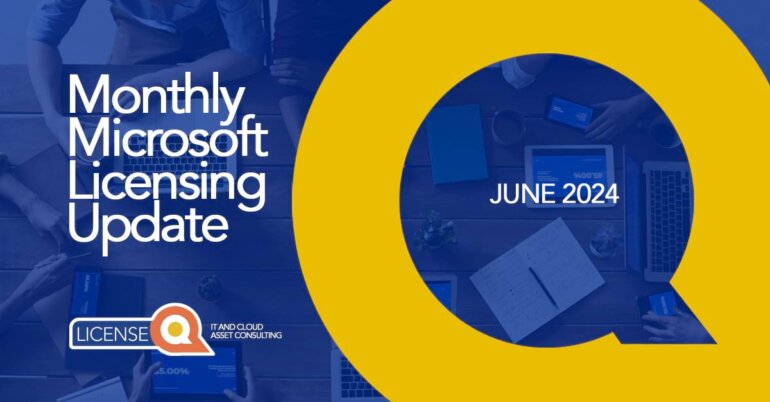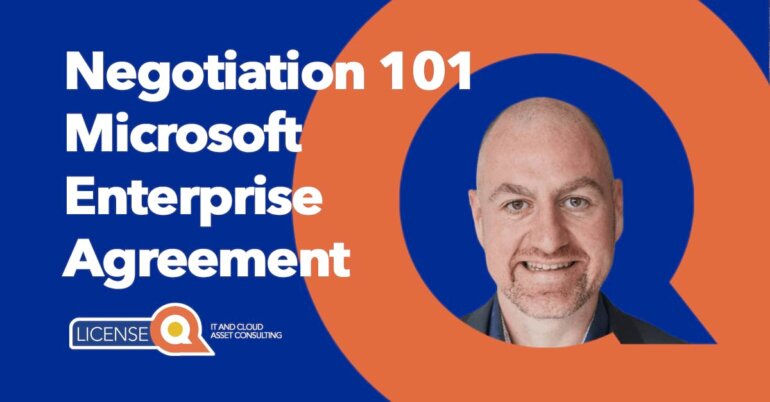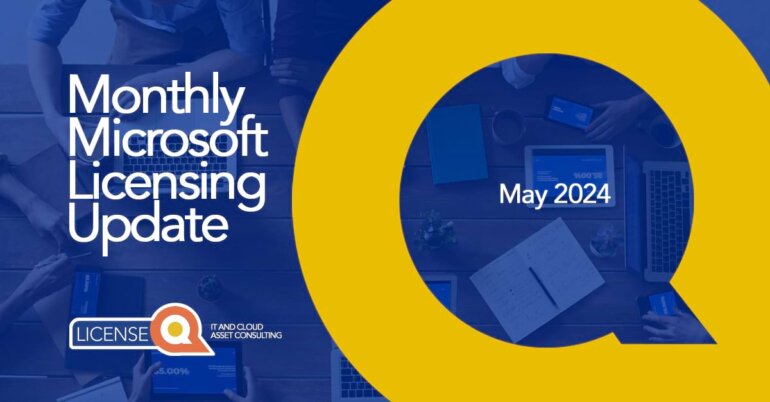Annual Report vs True-up
Difference between Annual Report vs True-up
Annual Report =
- Motion in the Enterprise Agreement Subscription contract
- It is an annual payment for the total number of licenses for Microsoft products and services that a company has agreed to.
True-up =
- Motion in the Enterprise Agreement
- It is an annual check to see what licenses an organization has used over the past year on top of the initial order.
- Also the subsequent process/payment to ensure that all additional licenses are paid. This ensures an organization is compliant.
- True-down is not an option for software products: you cannot pay for less licenses than were agreed on in the initial order.
Topics in this blog:
True-up
Annual Report
True-up
1. What is the True-up?
An Enterprise Agreement requires you to place a True-up at the end of each year.
The True-up is a comparison of the number of licenses used to the number of licenses purchased in the initial order of the Enterprise Agreement. The True-Up process allows companies to adjust their license count and purchase additional licenses, if required.
It is also a way for Microsoft to ensure an organization is complying with the Microsoft licensing terms and conditions for the different products and services. Generally, any growth throughout the year of the contract is considered for the True-up. The scaling down of cloud services can also be considered during the True-up as this is a programmatic option.
Unfortunately, there is no True-down principle for software (unless it is available as a subscription).
All the changes made over the year have to be reconciled in a True-up Report or an Update Statement, which need to be submitted 30 – 60 days before your EA enrollment anniversary.
The True-Up process ensures companies have the proper number of licenses to cover software usage. Because the products from the initial (renewal) report are price locked, the True-up process helps organizations budget for software expenses.
It also helps avoid unexpected costs or price increases. The terms and pricing of the products and services is agreed when signing the EA. These can be found in your Customer Price Sheet (CPS) under the Future Pricing Table.
The True-up process typically occurs:
- End of year 1
- End of year 2
- End of a contract term (also called ‘Final True-up’ or ‘True-up Year 3’)
An organization must review their software deployments and (cloud) usage against their licensing entitlements to determine if they have any licensing gaps. Important to stay in compliance and avoid legal/financial penalties.
2. What is the benefit of a True-up?
The process of procurement is simplified and easier to manage with a single annual True-up Report.
You are not required to immediately place an order for any increased usage of Microsoft software licenses. Instead, you can include all the growth at once at the end of the contract year.
One of the main benefits of a True-up within an Enterprise Agreement is that it allows organizations to accurately assess their software needs and adjust as necessary.
By conducting a True-up, organizations can identify areas where they may be over- or under-licensed (again, only for (cloud) subscriptions). They can adjust their license counts accordingly. This can help organizations optimize their software spending and avoid unnecessary costs.
Another True-up benefit is helping organizations maintain compliance with software licensing agreements. Many software vendors require organizations to maintain accurate records of their software usage. They must also ensure they are fully licensed for all software they use. Failure to comply with these requirements can result in penalties and legal consequences. This can be costly and disruptive.
Annual Report vs True-up

3. True-up reality check
The True-up is one of the more complicated parts of the EA. Microsoft’s EA program is designed to minimize risk while optimizing cost. This means that it’s not always possible to slash costs. Also, you cannot ‘True-down’ your software on an annual basis.
It gives you the option to use the licenses you have and only buy exactly what you need at set periodic intervals. This removes the tendency to over-purchase just to be safe.
Prices and terms for adding software and services are set at the start of the Enterprise Agreement. No surprises! Additional purchases are bundled into one report per year to reduce procurement costs. As opposed to paying for additional licenses each time.
License reservation
License reservation for cloud services helps defer costs for your additional cloud subscriptions. You can reserve licenses throughout the year at zero cost and reconcile these at the True-up period. Enabling you to add new online services at every moment in time to meet your needs.
Payment is retroactive for the months that you used cloud services in the active year of the 12 months leading up to enrollment. You pay immediately for the subsequent year of the contract.
The Subscription Enrollment not only gives you the option to add services and software, but also to remove them if needed. This is the annual reporting clients must do. License reservations for cloud services can be done in an EAS as well. They then need to be reconciled and taken into the total count of licenses for the subsequent year.
For a detailed explanation, watch the video below in which Floris explains the mechanics of the True-up.
Annual Report
1. What is the Annual Report?
The Annual Report is a key component of the Enterprise Agreement Subscription and it requires organizations to maintain licensing compliance. It ensures they purchase the latest software and services that they are using.
The Annual Report is a commitment that organizations make to purchase a certain number of licenses and subscriptions each year. Procurement is usually at a discounted price. This commitment is made in exchange for the benefits and flexibility that the EAS provides.
Annual payment
The annual payment covers the minimum number of licenses required by the agreement. Due to the nature of the EAS, the Annual Report is an all-up report for all software and services that an organization uses or plans on using in the upcoming year.
If additional licenses are used within that year, the contract stipulates the need to purchase additional licenses. However, many organizations are not aware of this and Microsoft typically does not audit this as they work based on a trust model for software. For cloud services an organization normally reports licenses in order for users to be able to access the service.
By committing to a certain number of licenses and subscriptions each year, organizations can ensure:
- usage of the latest software versions
- necessary licenses to use them legally.
The Microsoft Annual Report is also an opportunity for organizations to save money on their licensing costs. Locking in a certain number of licenses and subscriptions upon the renewal of the EAS contract means customers can leverage these prices throughout the term of the contract. This can result in significant cost savings over the course of the three-year agreement.

2. How does the Annual Report work?
To get the most out of the Annual Report you need to understand your software and cloud service needs. This requires a thorough analysis of the current software and services usage and future requirements. This analysis can help organizations determine the right number of licenses and subscriptions to commit to in their Annual Report.
LicenseQ can offer support with all the steps in the Annual Report process.
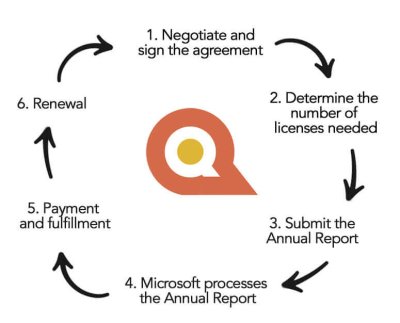
The Annual Report process for the Enterprise Agreement Subscription works as follows:
Negotiate and sign agreement
Before starting an Annual Report, an organization must first negotiate and sign the Enterprise Agreement Subscription with Microsoft. The agreement typically covers a period of three years. More about this process can be found in our blog here.
Determine number of licenses needed
Once the agreement is in place and the initial report is processed, you can use your software and services. Upon the contractual anniversary, an organization must determine the number of licenses it needs for the subsequent year. This can be based on the number of users, devices, or other criteria that software or cloud services are licensed on.
Submit the Annual Report
The organization then submits the Annual Report to Microsoft. This can be done through a Microsoft Licensing Solution Provider (LSP).
Microsoft processes the Annual Report
Microsoft reviews the report and confirms that the organization has submitted it correctly in accordance with the initial set up of the contract.
Payment and fulfillment
Once the report is processed, an organization pays for the licenses. Usually required within 30 days of the invoice. Upon the activation of the contract, Microsoft already grants access to the Volume Licensing Service Centre (VLSC), so any new required software can be downloaded here. Cloud services are usually assigned or consumed via their respective portals.
Renewal
At the end of the third year, you will need to renew your Enterprise Agreement and submit a new initial report to continue using the products and services covered by the agreement.
Generally this includes all software and services used in the final year of the agreement, including any new installations throughout this year and any license reservations done for cloud services.
Need support with your EA renewal?
In this blog we discussed the differences between Annual Report vs True-up, which are important terms when it comes to the EA(S). The EA remains a complicated licensing model to understand and work with. LicenseQ can provide immediate support and go through the EA process with you. For more information, visit our Contract Negotiation page or contact our licensing experts at info@licenseq.com.
Other articles in this series:
- The basics of the Enterprise Agreement
- How to set up an EA(S)
- Enterprise Agreement order requirements explained
- What is the difference between the Annual Report and the True-up?
- How does Software Assurance work?
- What are the different types of Enrollment?
- 10 tips to reduce your Enterprise Agreement spend
- Understanding the Enterprise Agreement Renewal process
- 5 tips for renewing your Enterprise Agreement

